Quadriceps pain is miserable. It turns running, squatting, and getting off the toilet into daunting endeavors.
This article covers everything you need to know about quad pain and how to treat it. Let’s jump right in!
Anatomy
The quadriceps femoris is a group of 4 large muscles on the front of the thigh: The vastus medialis, vastus intermedius, vastus lateralis and rectus femoris muscles.
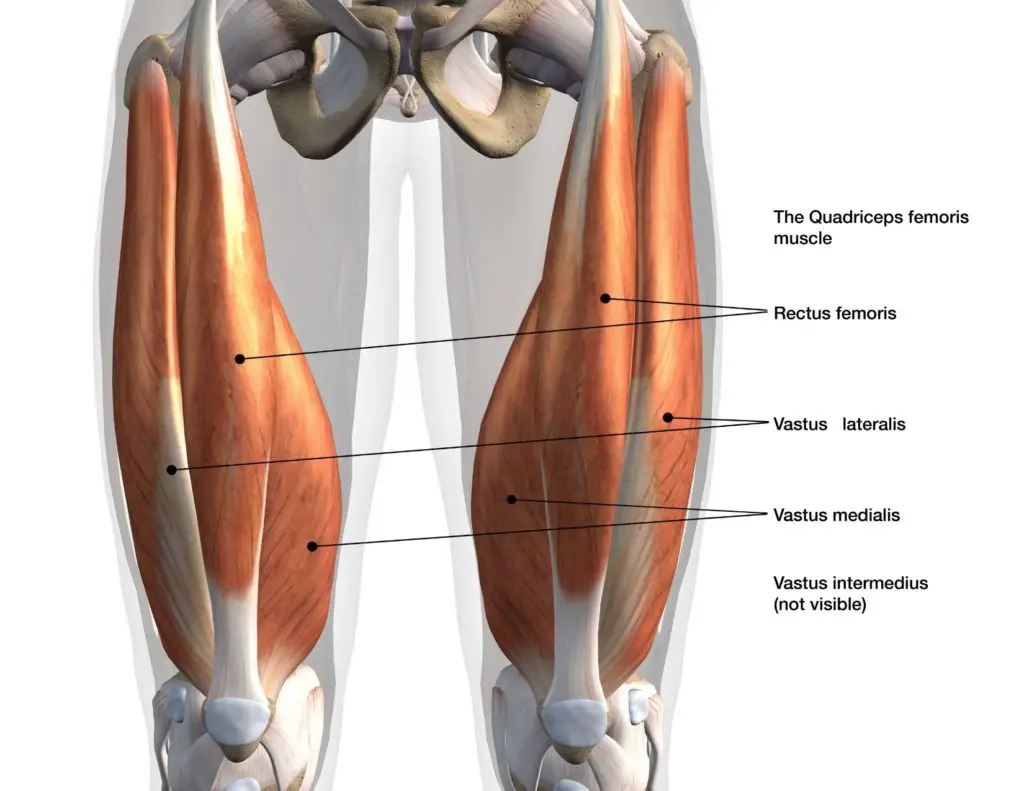
The femoral nerve (L2-L4) powers the quad muscles. Femoral nerve injury causes quadriceps weakness.
The quads attach to the kneecap (patella) via the quadriceps tendon. Below the knee cap, the patellar tendon connects the kneecap to the tibia (lower leg bone).
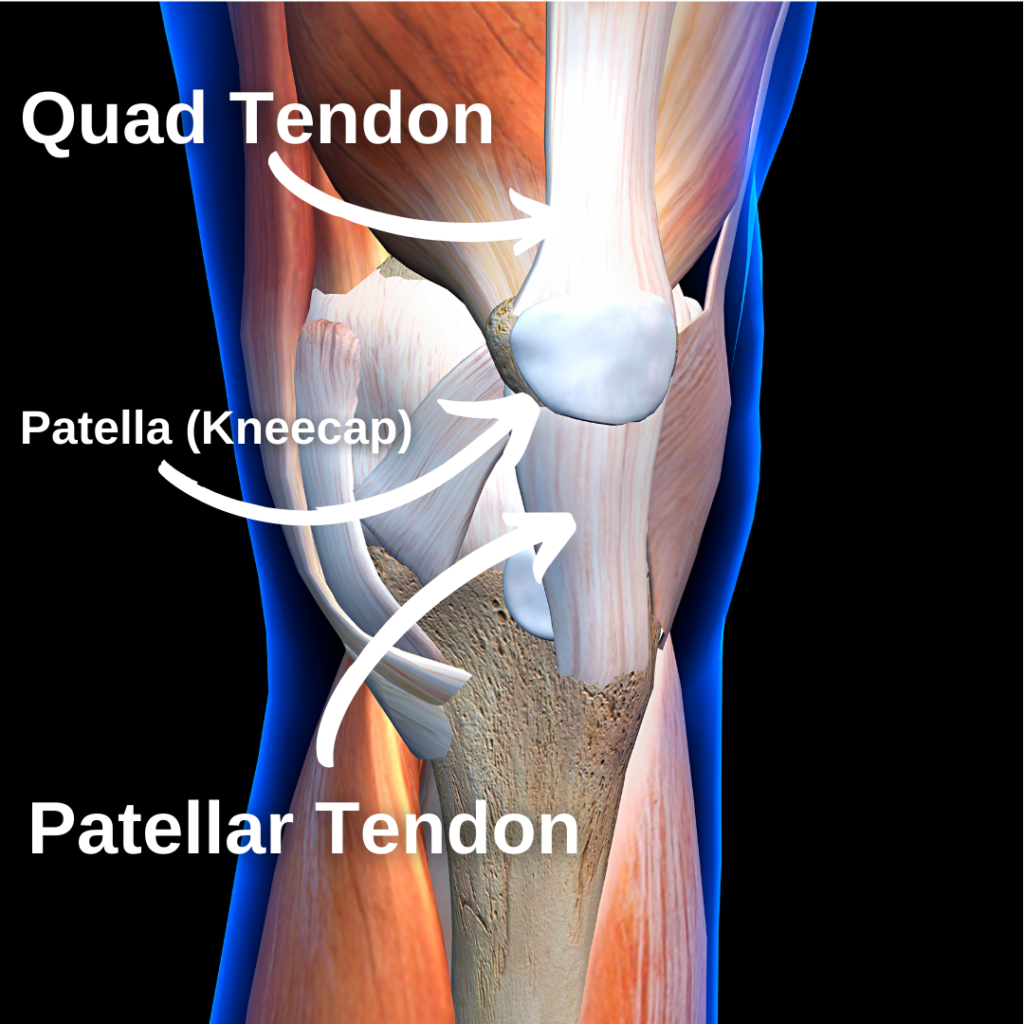
Most anterior (front) knee pain is caused by problems at the knee extensor mechanism: the quadriceps muscles, the quad tendon, the patella and the patellar tendon.
Function
All 4 quadriceps muscles powerfully extend (straighten) the knee joint. The rectus femoris muscle attaches above the hip joint and also flexes the hip.
Think of kicking a soccer ball or punting a football–this motion requires rapid hip flexion and knee extension. The quads power both motions.
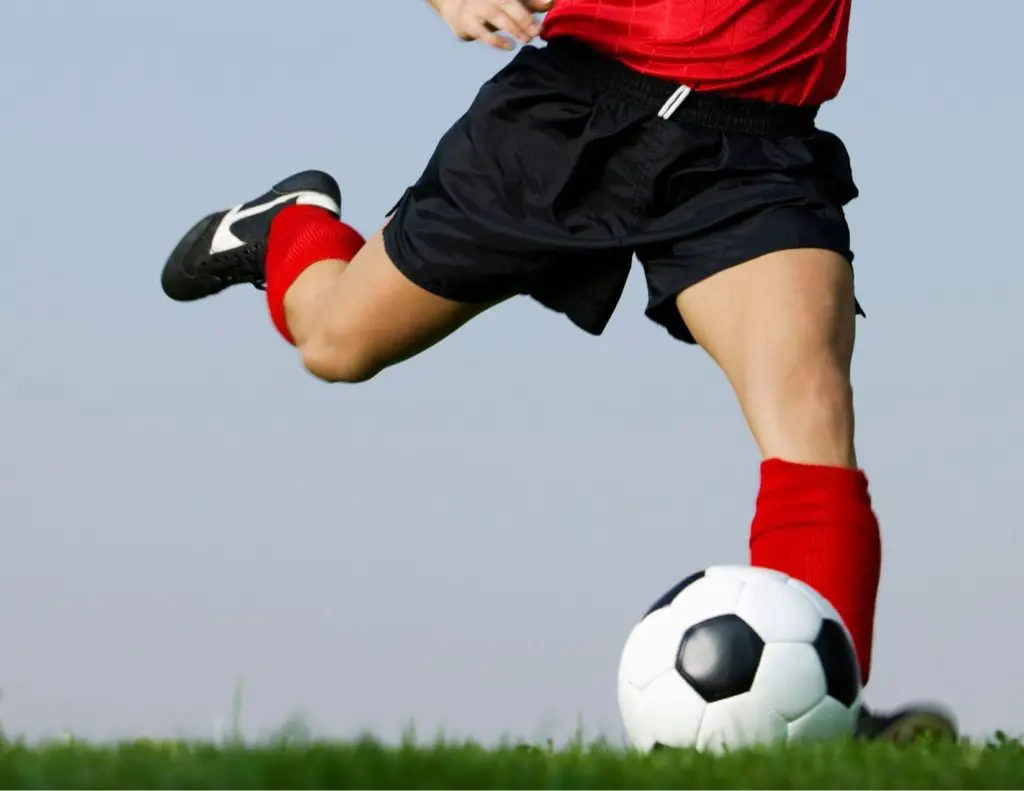
The quadriceps also play a pivotal role in daily function and physical activity. Strong quads translate to better athletic performance, more ease with daily activities, and better mobility in later adulthood.
In contrast, weak quads correlate to worsening knee pain (1), higher disability, and less independence with age. There’s even a relationship between quad weakness and cognitive decline in older adults (2).
With weak quadriceps, daily life is harder, too. It’s tough to go down the stairs, climb out of the car, and stand up from a low couch.
Strong quads are vital for recovering from knee surgeries, from ACL repairs to total knee replacements. Quad strength before knee replacement predicts knee function 6 months after surgery! (3)
The quadriceps are among the most important muscles in the body–though slightly less important than the heart and diaphragm!
What Causes Quad Pain?
Overuse causes most quadriceps pain.
Acute injuries can damage the quad muscles and cause quadriceps tendon injury. Major quad injuries occur with significant eccentric or high-velocity forces. Mechanisms include jumping down from a high surface or slipping and falling on a hyper-flexed (bent) knee.
These forces can cause small tears in the muscle or tendon–or in extreme cases, complete ruptures of the quad tendon. Quadriceps tendon tears require surgical repair and an extensive rehabilitation program. After surgery, patients wear a knee brace and abide by a long list of activity restrictions.
Fortunately, muscle tears and tendon ruptures are the exception rather than the rule. Quadriceps pain is usually an overuse injury caused by too much squatting, jumping, running, biking or lunging.
There are three common causes of pain above the knee:
1) Quad Tendon Pain
Quadriceps tendinopathy (or quadriceps tendinitis) causes pain at the top of the kneecap. Tendon pain is predictable. It’s always in the same location. It gets worse with activity, especially if the area isn’t warmed up.

The quadriceps tendon is aggravated by too much deep squatting, jumping, and gym exercises like the leg press and knee extension machines. Quad tendon pain causes discomfort at the top of the patella (kneecap).
Patellar tendinopathy, also known as jumper’s knee, creates patellar tendon pain below the kneecap. Both types of tendon pain occur with quadriceps overuse and resolve with appropriate loading–not too much, not too little.
Isometrics (e.g. wall sits) work wonders for tendon pain. Isometrics instantly relieve tendon pain (4), strengthen the quadriceps, and prime the tendon for action. Wall sits are my go-to warm-up exercise for knee tendon pain.
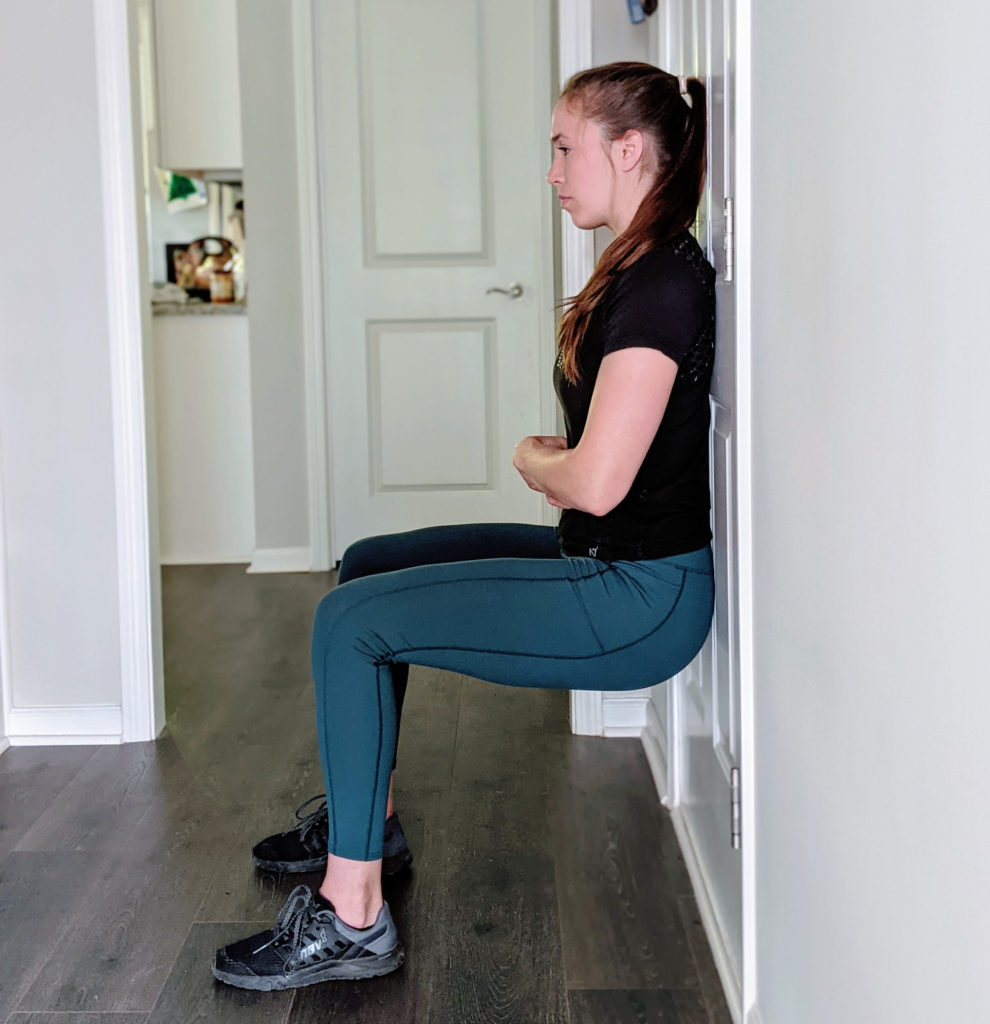
Reloading the tendon is essential for tendinopathy or tendonitis recovery. Loading the tendon remodels the injured tissue and strengthens the quadriceps. Some experts recommend pain-free exercise for tendon rehab, while others encourage exercising into moderate pain–5/10 or less (5).
My approach varies on the acuity and irritability of the symptoms. I instruct irritable patients (and those who have irritable knees) to avoid pain. Stable, predictable symptoms warrant a more aggressive approach, exercising into mild pain.
If patients decide to train into pain, I ask them to monitor their pain levels after exercise. Symptoms should return to baseline levels within a few hours. If not, they should reduce exercise intensity.
A patellar tendon counter-force brace dissipates force at the sore tendon and provides effective short-term pain relief so you can get on with your activities. Grab one here:

Quadriceps tendon pain is less responsive to counter-force bracing, but a knee sleeve can provide warmth to the irritated tendon and make running, jumping, and lifting less painful. I recommend this one to my patients:

2) Quadriceps Muscle Pain
Muscular issues cause pain in the front of the thigh. Severe injuries, such as torn muscles, occur rapidly due to a massive forces on the quads. Quadriceps tears can occur when landing from a substantial height or lifting a gargantuan weight.
More often, muscle pain develops over time due to overuse and under-recovery. Trigger points, which are tight, tender areas of the muscle, develop in the quadriceps muscles and refer pain to the front of the knee.
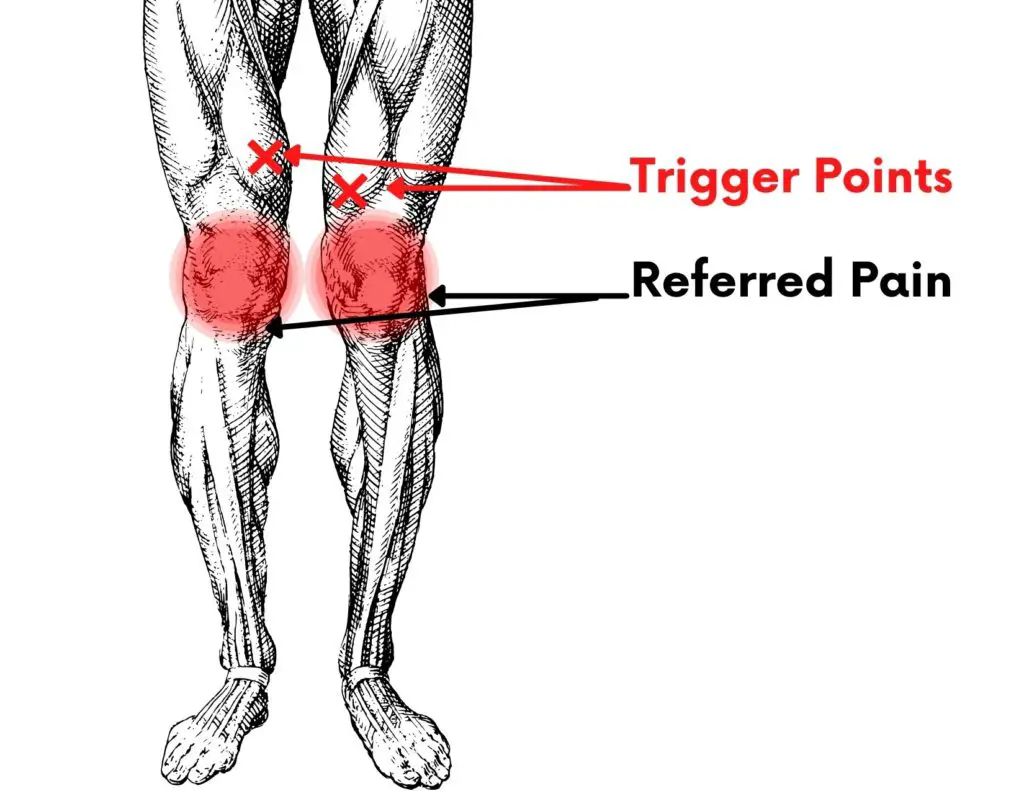
Soft tissue treatments like massage therapy and dry needling alleviate trigger points and muscular pain.
Along with soft tissue treatment, reducing quadriceps loading accelerates the healing process. Fortunately, the quadriceps muscles have excellent blood supply. Superior blood flow allows muscles to heal faster than structures with poor blood supply, like tendons.
3) Lumbar Spine Referral
Nerves in the lumbar spine power the quadriceps muscles. A pinched nerve in a low back can cause referred pain into the knee, along with leg weakness. In fact, over 25% of knee pain involves a lumbar component (6).

I use repeated motions to screen the lumbar spine in patients whose knee pain isn’t explained exclusively by local issues. On occasion, patients experience dramatic knee pain relief after a few low back stretches. It works like magic!
4) Hip Joint Referral
In rare cases, hip joint problems, like arthritis, cause referred pain to the top of the knee (7).
The Biggest Key to Recovery
The biggest key to recovering from quadriceps pain is appropriate loading.
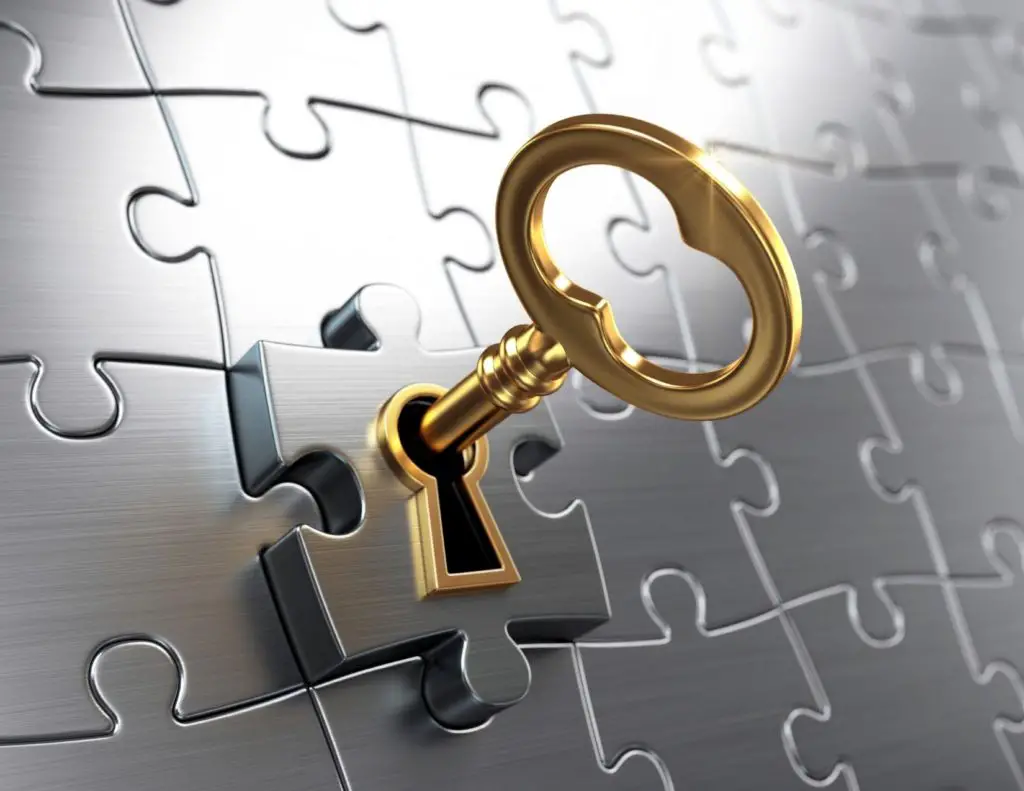
If it hurts every time you run 13 miles, stop running 13 miles! For overuse injuries, modify (but don’t eliminate) loading. This approach keeps muscles and tendons strong and allows aggravated areas to heal.
In quad pain rehabilitation, the goal is to load the irritated area without exacerbating symptoms. As pain levels diminish, it’s crucial to strengthen the quad muscles, along with the nearby hamstrings and hip muscles to facilitate a safe, pain-free return to activity.
I love working out. I experience the mental and physical benefits of regular exercise first-hand. So I never prohibit exercise for my active patients.
It’s negative for their physical health, mental well-being, and stress levels. Instead, we collaborate to modify their exercise program. We select exercises they can perform without hampering their recovery.
For example, runners often injure leg muscles. In the short-term, reducing weekly mileage and running frequency is required to allow healing. Instead of pounding the pavement 6 days a week, runners can bike, swim, or use the elliptical instead.

These cross-training options allow injured runners to maintain fitness without prolonging the recovery process.
My Battle with Quad Pain
Two years ago, in 2019, I added heavy high-bar squats to my lifting routine (which already included heavy low-bar squats once a week). My first mistake.
I tweaked my left quad first. Undeterred, I kept squatting. My second mistake.
A few weeks later, my right quad started hurting because I compensated for the left quad pain. I tried squatting less weight and squatting less often. I did cupping, massage, isometrics, and biking. I even dry needled my own quadriceps! But I kept squatting. My third mistake.
My legs kept hurting. Weeks turned into months, and a year after the first injury, my quads still hurt.
I felt exasperated because I couldn’t squat or deadlift without pain. I’m a powerlifter, and squats and deadlifts are ⅔ of the sport! (Bench press is the other lift).
I wish I could tell you the “one weird trick” that healed my quad pain. But there wasn’t an easy solution. In early 2020, I had to stop squatting during the stay-at-home orders.
Once my quads weren’t overloaded from squatting, they stopped hurting (amazing how that happens!). As of this writing, I can squat and deadlift without pain. And I’m within striking distance of my previous personal records!
Don’t be like me.
Let your body rest and heal if you’ve injured yourself. And don’t wait for a pandemic to strike before you do!
Another quick story: Four years ago, I dealt with quad tendon pain, which I handled better.
It started hurting during heavy squats. (See a pattern yet?) Body-weight squats hurt, so I stopped squatting for the day. No sense making it worse.
I took a week off squats and very slowly added them back into my routine. It took 6-8 weeks of patient progression before I could normal weight–but it didn’t hurt!
The latter example took more discipline but led to a much faster recovery. Learn from my mistakes.
Quad Pain Exercises
The following physical therapy exercises strengthen the quadriceps, hamstrings, and glutes.
Long Arc Quads
This simple exercise is a great way to get the quadriceps firing. Plus, it requires zero equipment. You can even do it while you binge your favorite Netflix show!
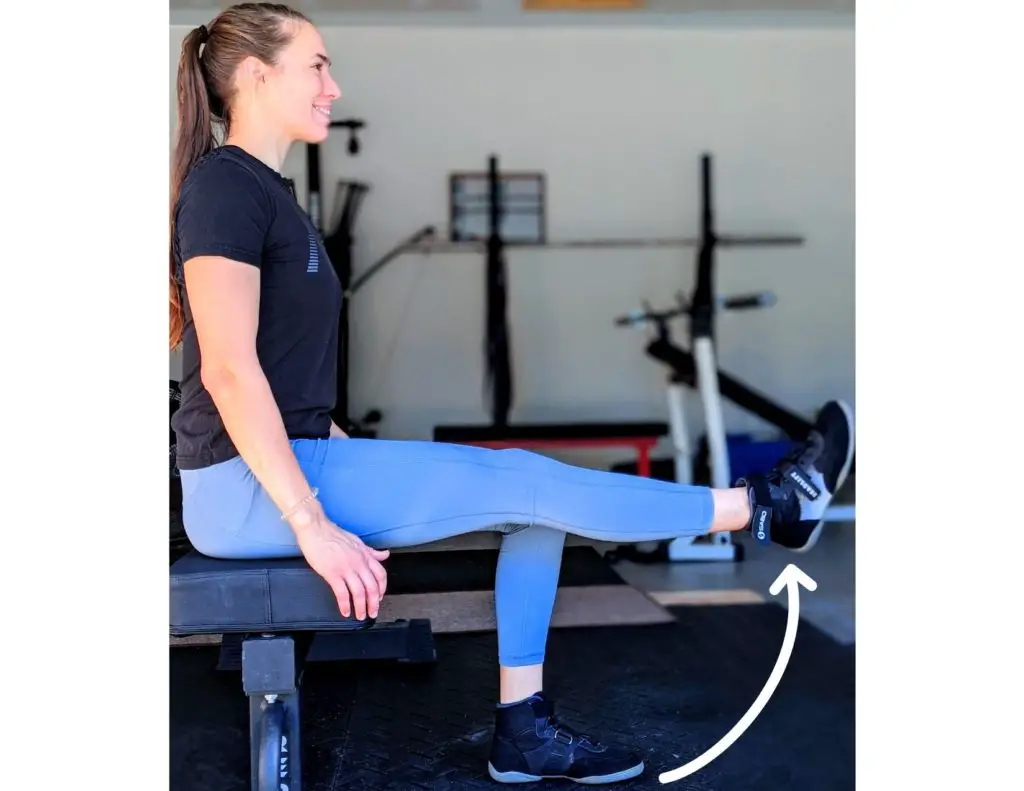
Long arc quads are usually pain-free. The exercise loosens up knees that get stiff from sitting. Try 10 repetitions, holding 5 seconds each. It’s harder than it looks!
Wall Sits
This exercise smokes the quads and can be scaled easily.

To make it easy, sit high with relatively straight knees. To make it difficult, sit in a low squat with the knees at 90°. Over time, increase the hold duration as you get stronger.
I use this isometric exercise as a pre-workout warm-up for quadriceps and patellar tendon pain.
Tempo Squats
Squats develop strong quads. Tempo squats are squats in slow-motion. Moving slower better controls the demands on the quadriceps muscles and tendons.
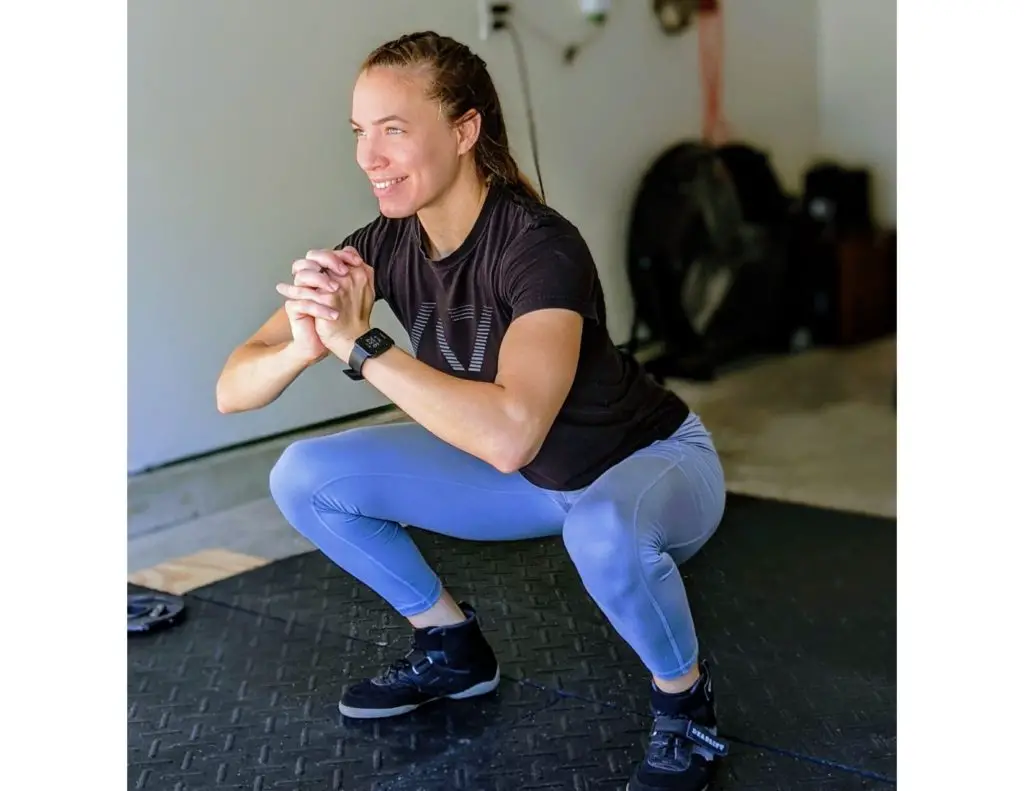
Use a snail’s pace of 4 seconds down and 4 seconds up. If body-weight tempo squats are too easy, add a little weight.

It doesn’t take much to feel the burn with these!
Reverse Nordic Hamstring Exercises
This exercise is all about quadriceps control. Eccentric exercises emphasize the lowering portion of exercise. They lengthen the muscle fascicles and reduce the risk of muscle strains (8).
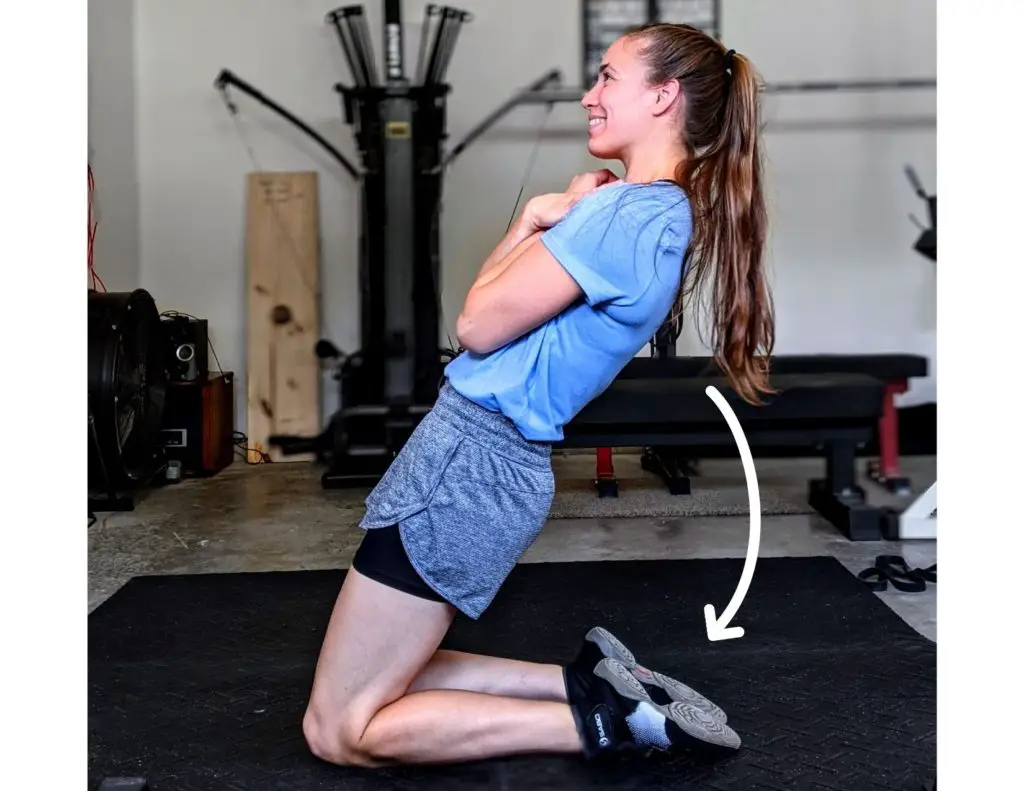
With reverse nordics, more motion means more difficulty. Start in an upright position and lean back very slightly. (Like you’re “reclining” on a plane.) Hold for 15 seconds.
As long as it’s not too painful, increase the range of motions, hold time, or repetitions.
This one lights up the quads!
Side Lying Hip Abduction
This exercise targets the gluteus medius muscles, the lateral hip muscles that control knee position in the frontal plane (side to side).
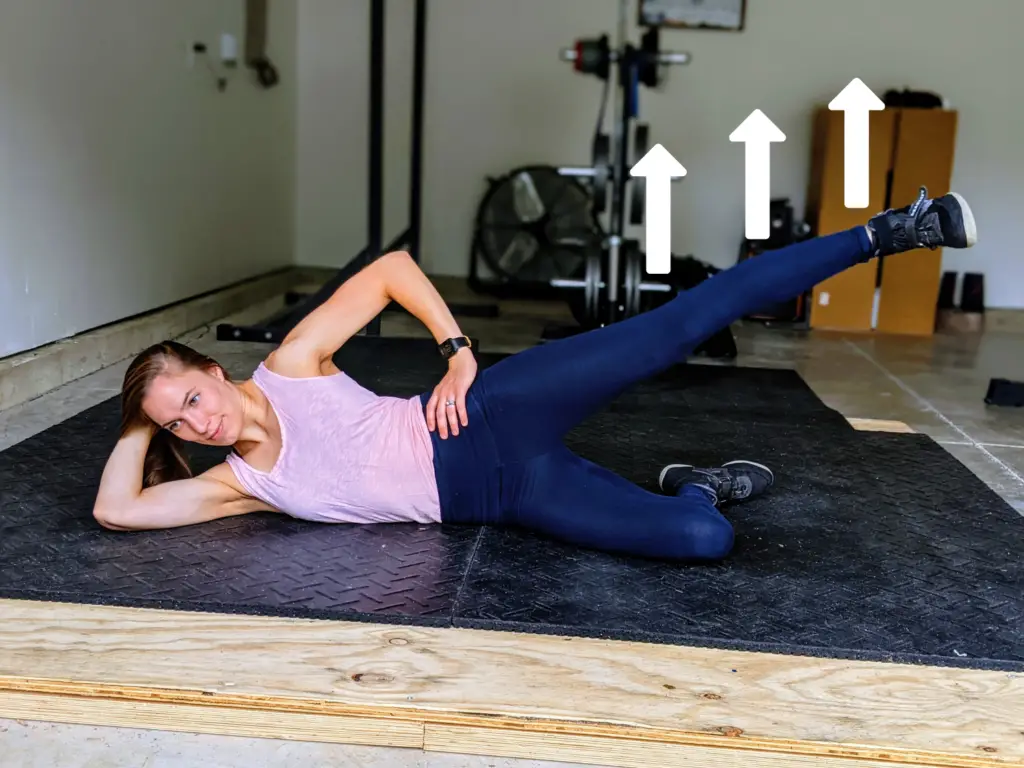
Keep the top leg straight and in line with your torso. Lift the leg towards the ceiling, and lower slowly back to the start position. 15 reps will have you feeling the burn on the outside of your hip.
Romanian Deadlifts
This exercise targets the posterior chain–spine extensors, glutes and hamstrings. It does not load the quadriceps much.
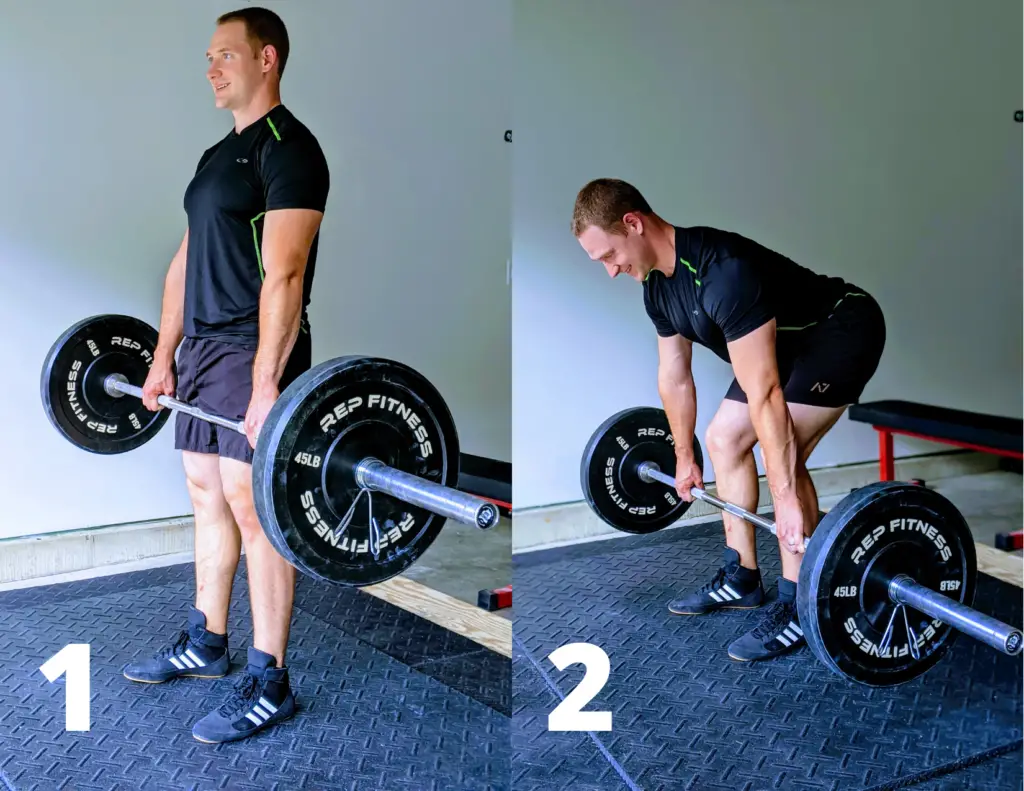
It’s a great exercise the build leg strength, even if the quads are irritable.
Final Thoughts
Mild quadriceps pain can morph into a nagging injury if it’s handled improperly. It happened to me!
We use our quadriceps every day–weakness and pain makes day-to-day activities difficult. Loading the quad muscles the right amount is the biggest factor in recovery.
Conservative treatments lead to good outcomes for quadriceps pain. Only the most severe cases, with extensive tissue damage, require knee surgery.
If you’ve been dealing with ongoing quad issues or have a serious injury, please see a sports medicine physician or physical therapist. I love Google too, but it can’t give you personalized health advice (yet). See a qualified health care provider so they can diagnose your problem, discuss your treatment options, and develop a customized treatment plan for you.
Want to feel better faster? Sign up for my free weekly newsletter for exclusive health tips and access to 7 Secrets to a Fast Recovery.


2 thoughts on “How to Recover from Quadriceps Injury (Pain Above the Knee)”
Great advice and very helpful. Thank you Jacob
Glad you found it helpful!